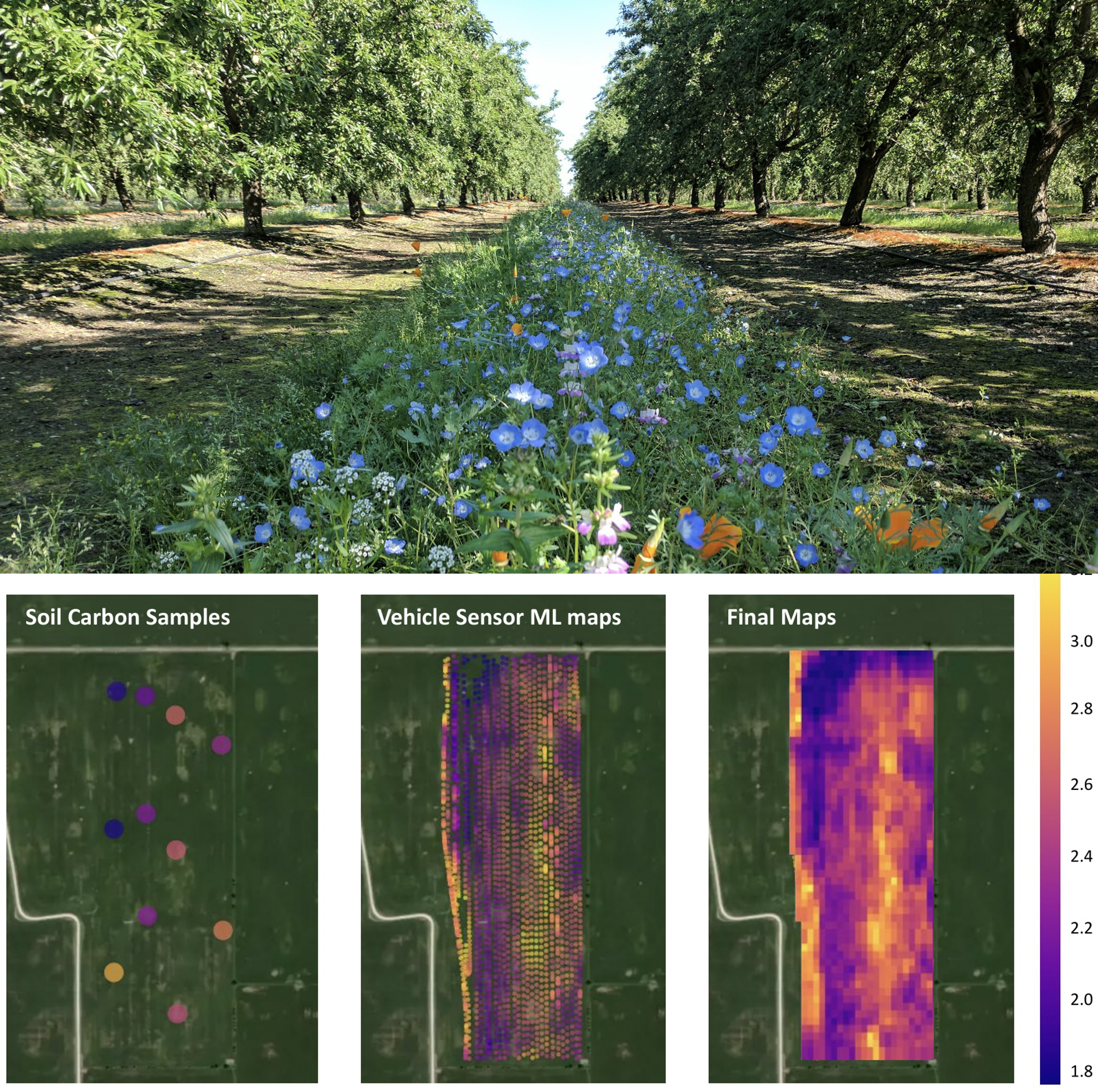Fifty years ago, when Xerces was founded as a butterfly conservation group, it had the potential to grow in many different directions. Ultimately, it did. Along with groundbreaking conservation in aquatic and terrestrial ecosystems, endangered species advocacy, pesticide policy work, and conservation targets as diverse as fireflies and mussels, Xerces has become an incubator for new approaches to agriculture.
This growth makes sense, as the links between invertebrate conservation and farming are obvious. At the same time, there are numerous other committed and heroic stakeholders working across the globe to make agriculture more sustainable. Much like those kindred spirits, Xerces is focused on a vision that we hope might contribute to a new roadmap for farming: farming that does more than grow food.
Xerces pioneered research and business solutions for pollinator protection
The origins of Xerces’ agricultural work began with our Pollinator Conservation Program, which launched in 2006. From the very beginning, the Pollinator Program operated on a bold model. Rather than focusing on wild bee research – a subject that was less well understood at the time – we took what limited research was already out there and tried to immediately apply it to the real-world conservation of wild bees on farms.
To do this, we were often working with incomplete information. What types of habitat systems could farmers tolerate in and around different crops? What wildflowers might best support some of the wild bees that contribute most to crop pollination? Out of necessity we constantly tested, evaluated, made adjustments, then tested some more. Over time, the total size of the farmlands we were working across ticked upwards from a couple of hundred acres to hundreds of thousands.
Complementing the work on wild bee conservation and habitats, we launched similar initiatives focused on conservation biocontrol (the management of wild beneficial insects to suppress crop pests), and the conservation of soil invertebrates. Our eco-label certification, Bee Better Certified, ties these conservation targets together through a formal accreditation system that allows food products produced with practices that support bees to use the Bee Better label on their packaging. Since its launch, global food companies such as Nestle¢, Danone, Walmart, and KIND Bar have all made commitments around sourcing Bee Better Certified ingredients.
Regenerative agriculture opens new frontiers in conservation
In recent years, invertebrates on farms have received a little more mainstream attention, often under the broader umbrella of “regenerative agriculture,” a loosely defined philosophy that proposes farms should improve rather than diminish natural resources. This is good news, and something to celebrate, even when much of the other news that surrounds us seems bleak.
However, there is still a tremendous amount to do. In many ways, the larger regenerative agriculture movement is in the same place Xerces was with pollinators in 2006. Just as we didn’t have all the answers to bee conservation, the regenerative movement is now confronting its own countless unknowns: How can cropping systems be modified to increase soil carbon? How can practices such as cover cropping be integrated to increase water and nutrient resources, without detrimentally impacting harvest practices or yield?
At Xerces, we’re asking a lot of our own questions that cross over into this same regenerative space:
- How can we most effectively “stack” or combine natural resource benefits on farms?
- How can pollinator habitat systems such as hedgerows or wildflower field borders contribute to carbon sequestration?
- What kinds of farm conservation practices are most resilient in the face of climate instability?
- How do we support rare and declining pollinators in the most intensively farmed landscapes?
 Our work, such as this habitat complex squeezed between two large blocks of almond orchards, is being implemented in some of the most intensively-farmed landscapes on earth. (Image: Cameron Newell, The Xerces Society.)
Our work, such as this habitat complex squeezed between two large blocks of almond orchards, is being implemented in some of the most intensively-farmed landscapes on earth. (Image: Cameron Newell, The Xerces Society.)
New research will seek on-farm solutions that balance changing climate, markets, and biodiversity
Most of these questions exist at the emerging nexus of climate and biodiversity. At the same time as pollinators decline, farming is facing greater challenges from drought, extreme heat, flooding, and severe storms. War, COVID, shipping disruptions, inflation, increased input costs and labor shortages are further stressing the food system, making it even more imperative that we maximize the impacts of every conservation investment.
To that end, Xerces is now launching the next era of our on-farm trials. With supporting investments from the USDA National Resources Conservation Service (NRCS), we recently inaugurated a five-year, multi-state research and development project focused on evaluating conservation practices that simultaneously maximize climate resilience, biodiversity, and market incentives. In many ways, this work is informed by initial findings from our regenerative work with General Mills, where we have recently deployed conservation practices across almost 90,000 acres of the company’s supplier farm lands.
In the years ahead, this project will deploy and evaluate conservation systems that we think might concurrently sequester soil carbon, increase the water holding capacity of soils, facilitate the survival of climate-sensitive species, and increase the abundance of pollinators and predatory insects. To test our successes in these areas, we will be conducting extensive field surveys of insects and evaluating how various species of habitat plants survive under conditions such as drought. We’ll be implementing some incredible new soil mapping technologies that use ground penetrating radar and artificial intelligence to help document changes in soil where conservation practices are adopted.
 To better understand how practices such as cover cropping increase soil health and soil carbon sequestration, we are launching a new effort to deploy soil mapping technologies across many of our projects. (Image: Earth Optics, and The Xerces Society.)
To better understand how practices such as cover cropping increase soil health and soil carbon sequestration, we are launching a new effort to deploy soil mapping technologies across many of our projects. (Image: Earth Optics, and The Xerces Society.)
We’ll also be diving deeper into sustainability marketing to leverage carbon markets, eco-labels such as Bee Better Certified, and other credentials that provide consumers with transparency into how their food is produced. This work will also cut through greenwashing and empower food companies to make credible claims around environmental benefits.
Behind all of this is a new emphasis on data capture and management, both geospatial and quantitative in order to map and evaluate project impacts while number-crunching which pollinator types are benefiting most from farm conservation practices and which habitat features are delivering the biggest impact. At various stages throughout the project ahead, we’ll share that data as it becomes available and starts to yield identifiable trends.
Central to the entire enterprise is the direct collaboration, ideas, and enthusiasm of the farmers themselves. Operations such as Vilicus Farms in Montana, AC Foods in Oregon and California, the Zirkle Fruit Company in Washington, and dozens of other farms across the country are already working with us at the forefront of systems innovation to integrate beneficial insects, soil health, pollinator habitat, and climate resilience into their production systems. Every day we learn key lessons from their leadership and vision.
Back when the pollinator program launched in 2006, one of its first endeavors was the publication of our Farming for Bees handbook. The title turned out to be prescient. In fact, it was our first acknowledgement of the idea that farms could grow more than food. Perhaps they could also grow and sustain wild bees. Today, we’re drawn to an even bigger notion than the potential for farms to grow food and bees: Perhaps they can grow a whole ecosystem of resources all at once.







